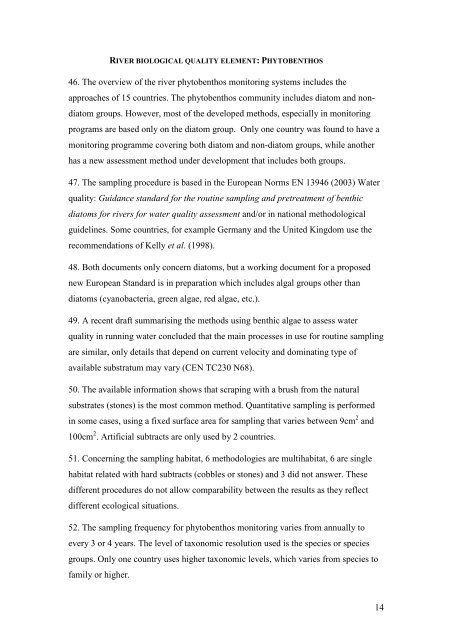Report on Harmonisation of freshwater biological methods
Report on Harmonisation of freshwater biological methods
Report on Harmonisation of freshwater biological methods
Create successful ePaper yourself
Turn your PDF publications into a flip-book with our unique Google optimized e-Paper software.
RIVER BIOLOGICAL QUALITY ELEMENT: PHYTOBENTHOS46. The overview <strong>of</strong> the river phytobenthos m<strong>on</strong>itoring systems includes theapproaches <strong>of</strong> 15 countries. The phytobenthos community includes diatom and n<strong>on</strong>diatomgroups. However, most <strong>of</strong> the developed <strong>methods</strong>, especially in m<strong>on</strong>itoringprograms are based <strong>on</strong>ly <strong>on</strong> the diatom group. Only <strong>on</strong>e country was found to have am<strong>on</strong>itoring programme covering both diatom and n<strong>on</strong>-diatom groups, while anotherhas a new assessment method under development that includes both groups.47. The sampling procedure is based in the European Norms EN 13946 (2003) Waterquality: Guidance standard for the routine sampling and pretreatment <strong>of</strong> benthicdiatoms for rivers for water quality assessment and/or in nati<strong>on</strong>al methodologicalguidelines. Some countries, for example Germany and the United Kingdom use therecommendati<strong>on</strong>s <strong>of</strong> Kelly et al. (1998).48. Both documents <strong>on</strong>ly c<strong>on</strong>cern diatoms, but a working document for a proposednew European Standard is in preparati<strong>on</strong> which includes algal groups other thandiatoms (cyanobacteria, green algae, red algae, etc.).49. A recent draft summarising the <strong>methods</strong> using benthic algae to assess waterquality in running water c<strong>on</strong>cluded that the main processes in use for routine samplingare similar, <strong>on</strong>ly details that depend <strong>on</strong> current velocity and dominating type <strong>of</strong>available substratum may vary (CEN TC230 N68).50. The available informati<strong>on</strong> shows that scraping with a brush from the naturalsubstrates (st<strong>on</strong>es) is the most comm<strong>on</strong> method. Quantitative sampling is performedin some cases, using a fixed surface area for sampling that varies between 9cm 2 and100cm 2 . Artificial subtracts are <strong>on</strong>ly used by 2 countries.51. C<strong>on</strong>cerning the sampling habitat, 6 methodologies are multihabitat, 6 are singlehabitat related with hard subtracts (cobbles or st<strong>on</strong>es) and 3 did not answer. Thesedifferent procedures do not allow comparability between the results as they reflectdifferent ecological situati<strong>on</strong>s.52. The sampling frequency for phytobenthos m<strong>on</strong>itoring varies from annually toevery 3 or 4 years. The level <strong>of</strong> tax<strong>on</strong>omic resoluti<strong>on</strong> used is the species or speciesgroups. Only <strong>on</strong>e country uses higher tax<strong>on</strong>omic levels, which varies from species t<strong>of</strong>amily or higher.14














![Accommodation booking form [PDF]](https://img.yumpu.com/39471785/1/184x260/accommodation-booking-form-pdf.jpg?quality=85)

